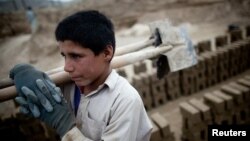BANGKOK - The United Nations International Labor Organization (ILO) is reporting progress in reducing the numbers of children in working in illegal and hazardous employment, partly because of government efforts to address the problem. Some 168 million children worldwide are still employed as child laborers, nearly half of them in Asia.
The International Labor Organization says of the 168 million children globally working as child laborers, 77 million are to be found in Asia Pacific countries.
Of those, the ILO says there are more than 34 million involved in hazardous work that directly endangers their health, safety and moral development.
Simrin Singh, an ILO specialist on child labor in the Asia Pacific says agriculture is the main culprit as child farm workers can be exposed to dangerous chemicals and manual labor. But there are growing numbers of children from middle income countries who are doing unsafe work in manufacturing and service industries.
"Agriculture is still the biggest culprit where you find hazardous work but there's also high levels in the manufacturing and service sector; but agriculture accounts for the largest number of children engaged in child labor."
In Laos,, 90 per cent of child labor is found in agriculture while in middle income Indonesia the figure is around 55 per cent in agriculture and 30 per cent of children in the service sector.
But there has been progress. Globally, there are almost 78 million fewer child laborers in 2012 than when researchers started tracking in 2000. The number of girls working as child laborers fell by 40 per cent during that time. Boys fell by 25 per cent. But this progress, the report says, remains fragile.
Singh says the Asia Pacific region is falling short in reaching targets to eliminate child labor with many child laborers "unseen" while working as domestic laborers in people’s homes.
"In Asia also in many other parts much of child labor remains hidden. Certain forms of child labor are not well captured - such as child domestic work, children in child
domestic labor because they are hidden from public eyesight."
Singh says positive factors have supported the improvement, including better government policy and awareness. She says Indonesia, the Philippines, as well as India and China have taken steps to implement significant social protection plans.
But Singh says her main fear about future progress is government complacency.
"I really am very concerned about this issue of complacency because this is the last thing that needs to happen. We will not meet the 2016 goal - in fact we're probably not even going to meet the goal four years later - 2020."
The ILO says eradicating child labor requires a broad legal and social approach that improves children's access to education, boosts social protection for vulnerable groups, and reforms labor markets to ensure better wages and worker protections.
The International Labor Organization says of the 168 million children globally working as child laborers, 77 million are to be found in Asia Pacific countries.
Of those, the ILO says there are more than 34 million involved in hazardous work that directly endangers their health, safety and moral development.
Simrin Singh, an ILO specialist on child labor in the Asia Pacific says agriculture is the main culprit as child farm workers can be exposed to dangerous chemicals and manual labor. But there are growing numbers of children from middle income countries who are doing unsafe work in manufacturing and service industries.
"Agriculture is still the biggest culprit where you find hazardous work but there's also high levels in the manufacturing and service sector; but agriculture accounts for the largest number of children engaged in child labor."
In Laos,, 90 per cent of child labor is found in agriculture while in middle income Indonesia the figure is around 55 per cent in agriculture and 30 per cent of children in the service sector.
But there has been progress. Globally, there are almost 78 million fewer child laborers in 2012 than when researchers started tracking in 2000. The number of girls working as child laborers fell by 40 per cent during that time. Boys fell by 25 per cent. But this progress, the report says, remains fragile.
Singh says the Asia Pacific region is falling short in reaching targets to eliminate child labor with many child laborers "unseen" while working as domestic laborers in people’s homes.
"In Asia also in many other parts much of child labor remains hidden. Certain forms of child labor are not well captured - such as child domestic work, children in child
domestic labor because they are hidden from public eyesight."
Singh says positive factors have supported the improvement, including better government policy and awareness. She says Indonesia, the Philippines, as well as India and China have taken steps to implement significant social protection plans.
But Singh says her main fear about future progress is government complacency.
"I really am very concerned about this issue of complacency because this is the last thing that needs to happen. We will not meet the 2016 goal - in fact we're probably not even going to meet the goal four years later - 2020."
The ILO says eradicating child labor requires a broad legal and social approach that improves children's access to education, boosts social protection for vulnerable groups, and reforms labor markets to ensure better wages and worker protections.






